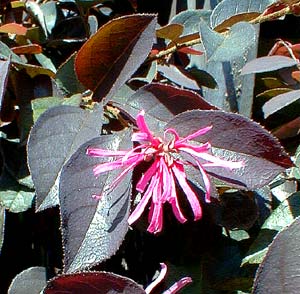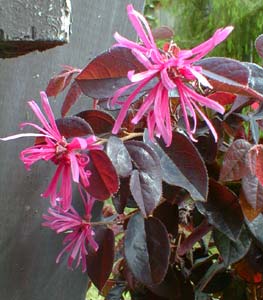
'Sizzling Pink' Chinese Fringe Flower;
or, Chinese Witch Hazel
Nihonkaki Nursery in Kawaguchi City, Japan, provided the first pink-flowering burgundy-leafed varieties of Fringe Flowers (Loropetalum chinense var rubrum) to the U.S. National Arboretum in the late 1989. Soon others were being imported & given American cultivar names, often without bothering to notice the same cultivars were already in production under different names, leading to considerable confusion as to how many cultivars began the Chinese Fringe Flower craze.
When the only L. chinense in the marketplace had white strap-flowers & green leaves, it was a seldomly gardened shrub. The pink bloom earlier than the white, possibly because the dark leaves absorb more heat, & are quite showy set off boldly flashing pink against dark burgundy, whereas the green forms tend not to show off the white flowers very well. Increasingly it is the pink forms that are making major inroads into gardened landscapes. The pink blooms with deep plum or burgundy leaves shot the species from relative obscurity to garden standard within a decade. Further varieties are being developed & field-tested every year.
By the year 2000 this formerly little-utilized shrub seemed to have about two-dozen burgundy-leafed cultivar offerings in the trade, though some were the same cultivars under sundry names, as in the case of 'Plum Delight' reaching the market under the alternative names 'Hines Purpleleaf,' 'Hines Burgundy' & 'Pizzazz.'
 The variety 'Sizzling Pink' can reach four to six feet of height, & spread four or five feet wide. The size & behavior of different cultivars of rubrum can vary extremely. Some have purple foliage only in spring; 'Ruby' is a true dwarf; 'Burgundy' has the best chance of becoming a tree. 'Sizzling Pink' has one of the blackest burgundy foliages which greens up a bit as the year progresses but never entirely loses at least a purple sheen.
The variety 'Sizzling Pink' can reach four to six feet of height, & spread four or five feet wide. The size & behavior of different cultivars of rubrum can vary extremely. Some have purple foliage only in spring; 'Ruby' is a true dwarf; 'Burgundy' has the best chance of becoming a tree. 'Sizzling Pink' has one of the blackest burgundy foliages which greens up a bit as the year progresses but never entirely loses at least a purple sheen.The natural species is a mounding shrub when young, a small tree eighteen to fifteen feet when muture, & specimens in its native China reach 25 feet. 'Sizzling Pink' remains smallish & very compact, & its floppy habit would be difficult to train into a tree form, so it is ideally trained to a trellis, espaliered as a "wall shrub" or semi-vine, akin to Blue Potato Vine.
They do well & flower best in full sun but soil must be kept moist. Like evergreen rhododendrons, it is susceptible to desication from winter wind & harsh winter sunlight, so may need some protection. In Zone 8 mulching probably isn't necessary, but the shallow roots can susceptible to winter damage & mulching would be a good idea wherever temperatures fall into the teens, & in the lower teens the shrub may die, especially if grown in a container. It bounces back quickly from sheering & can be incorporated into a mixed hedge. It is easily propagated from cuttings.
It will be most at risk its first year & once well established in the ground, it should survive winters even at zero to ten degrees F., just so long as the chill is not extended. A North Carolina field testing of many cultivars found that they all survived winters down to 5 degrees with just a few cultivars having tip-damage that would need trimming off in spring, & this fault was particularly so with 'Blush' & 'Sizzling Pink.' The best performer for cold-hardiness & for leaf & flower beauty was 'Zhuzhou Fuchsia' which would be preferable to 'Sizzling Pink' if offered, though 'Sizzling Pink' is also a lovely plant, & in our zone will not experience sufficient chill to have any winter damage.
It is frankly a Zone 8 to 9 plant primarily, but is worth trying in zone 7 & should do quite well up next to a house experiencing residual warmth during winter. The North Carolina study found that only 'Plum Delight' consistently survived Zone 7 winter without at least tip-damage. 'Blush' was severely damaged, 'Sizzling Pink' a bit less, 'Zhuzhou Fuchsia' even less so that it was completely recovered & perfect in its beauty by May.
Same for overheating in summer; if roots dry out or are directly sunned, the shrub could be very stressed, though once well established it can prove to be drought tolerant. An evergreen or rhododendron fertilizer after the first rush of spring blossoms is a good idea.
The marvelous leaves are evergreen for a first-rate year-round presence. Flowering has a tepid beginning in late winter & early spring, at about the same time the winter jasmine is having its first full flowering. Flowering increases in intensity until it is heaviest in May & June. Reblooming will occur summer & early autumn, until first frost or so.
The fragrant strap-petalled flowers resemble those of star magnolia or witch hazel. Chinese Fringe Flower is in fact a close relative of witch hazel. The species is native to Japan, southern China, & northeastern India. The original wild burgundy-leafed variant may well have been more restricted to southern China, but has long been dispersed in China & Japan in cultivated forms. It was not described until 1942, when thickets of it were found in the wilds of Hunan province. Its botanical status as a variant is debatable & rubrum may have originated in southern China as a cultivated sport which subsequently found its way into the wild.
The Chinese name of the green-leafed form is Ju Mu, with the variant rubrum called Jong hua ji mu. As a medicine it is known as Chi hua or Chih mo hua. It has at the very least the same astringent qualities & values as Witch Hazel, plus many alleged healing values for heart & liver ailments, diarrhea, or soar throat. Potentially active flavonol glycoside content is richest in the roots & flowers, though as with the majority of processed herbal remedies, marketed 100% pure powdered or capsule product often contains mainly leaves & twigs which vastly reduces any possibility of any healthful response beyond the palcebo effect.